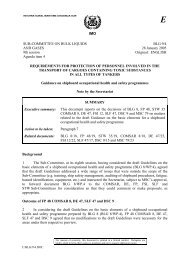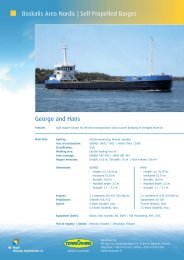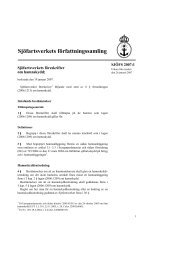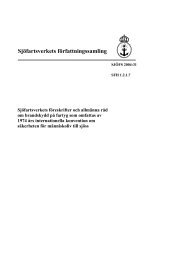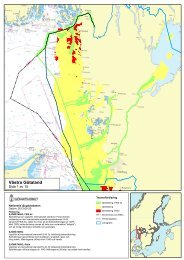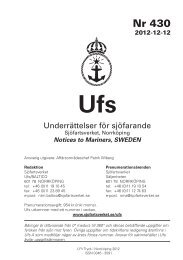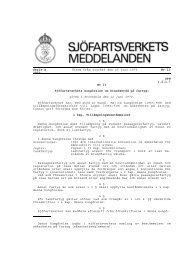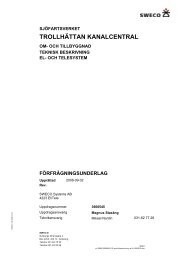AIS - Automatic Identification System
AIS - Automatic Identification System
AIS - Automatic Identification System
Create successful ePaper yourself
Turn your PDF publications into a flip-book with our unique Google optimized e-Paper software.
do it every time the radar tracking has swapped to another<br />
target or, when the ferry has been moored to a pier or passed<br />
too close to a beacon or a passing ship.<br />
● Know which port a ship is bound for.<br />
● Know the size and the draft of ships in the vicinity.<br />
● Detect a change in a ship’s heading almost in real time.<br />
● Identify slowly moving targets, like log rafts, sounding arrays<br />
etc., which are unable to take rapid evasive actions.<br />
The only <strong>AIS</strong> solution, that could solve all the requirements<br />
of the VTS, is a high update rate, mode <strong>AIS</strong>, with interrogating<br />
capabilities.<br />
The establishment of a landbased <strong>AIS</strong> reception network,<br />
may actually mitigate the need for VTS in some areas. The cost<br />
of installing and maintaining an <strong>AIS</strong> network is minute compared<br />
to a VTS radar net-work.<br />
Marine Search and Rescue (SAR)<br />
SAR operations would be much more efficient if all the<br />
Rescue Units (RU) were fitted with <strong>AIS</strong> to quickly identify the<br />
ship closest to a distress situation.<br />
During a search operation all the crafts could be tracked and<br />
plotted enabling the Marine Rescue Co-ordination Centres<br />
(MRCC) to monitor the progress, to direct the available<br />
resources efficiently and to ascertain a search coverage without<br />
gaps. Furthermore, all surrounding ships and RU´s as well as<br />
the MRCC could identify an <strong>AIS</strong> equipped ship in distress.<br />
The actual emergency status of the ship could also be determined<br />
automatically.<br />
Man Over Board (MOB) alarm will most probably be one of<br />
the features allowing all other ships in vicinity to have the same<br />
MOB position displayed, when one of the ships have activated<br />
the MOB alarm.<br />
Fishing boats and pleasure crafts<br />
Most of the small ships will not be equipped with <strong>AIS</strong> which<br />
makes the radar the most important sensor to detect their existence.<br />
If mandatory <strong>AIS</strong> carriage requirement could be applied to<br />
fishing vessels, it would enable national fishing agencies to<br />
enforce fishing restrictions more efficiently.<br />
Shore based pilotage – heading<br />
The captain on a ship with no radar or a radar disturbed by<br />
sea/ rain clutter and with a very weak radar return from shore<br />
and navigational aids, may today be assisted with his navigation<br />
if he is able to get navigational assistance from shore.<br />
Shore based pilotage with radar is normally limited to small<br />
and moderately sized ships which generally are more manoeuvrable<br />
than, for example, large tankers. The limitations of radars,<br />
makes shore based pilotage suitable only in areas where the<br />
navigable water is sufficient to separate the traffic, and where<br />
the ship could be supervised only by giving bearings to, for<br />
example, waypoints.<br />
If only the DGPS position from a ship, but no heading, is<br />
transmitted via the <strong>AIS</strong> the VTS operator will get an exact position<br />
of the ship’s antenna at the moment, as well as the speed<br />
and course over ground for the same antenna. The ships heading<br />
and the position of other parts of the same ship, at the<br />
same moment, is however<br />
unknown. This uncertainty<br />
of the real situation<br />
could lead to mistakes of<br />
importance. For instance,<br />
a 350 meter long tanker<br />
with the antenna situated<br />
on top of the wheelhouse<br />
at the stern, starts to turn<br />
to starboard. The ship’s<br />
course will then change to<br />
starboard, but initially the<br />
stern with its antenna will<br />
swing slightly to port, as<br />
the ship is turning around<br />
its so called pivot point.<br />
There is obviously, besides<br />
to determine and transmit<br />
the exact position of the<br />
antenna, a need to include<br />
the heading in the transmission. The ARPA radar tracks the<br />
part of the ship, which gives the best radar return, normally on<br />
a loaded tanker the superstructure at the stern. A big tanker,<br />
turning with the superstructure at the stern tracked by radar,<br />
could have turned 30-50 degrees, before this is detected by the<br />
ARPA radar, on another ship or at the VTS, and now up to 4-5<br />
minutes has passed since the turn started.<br />
4 <strong>AIS</strong> for ships in the future




